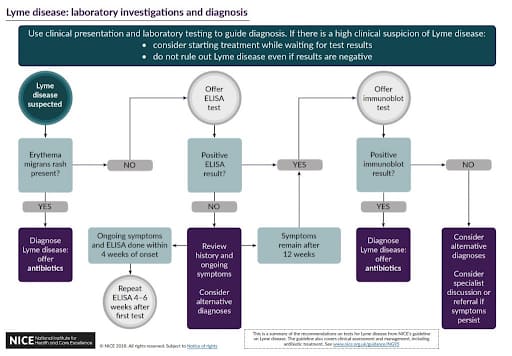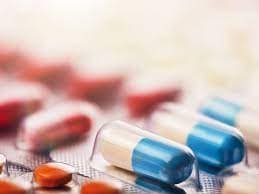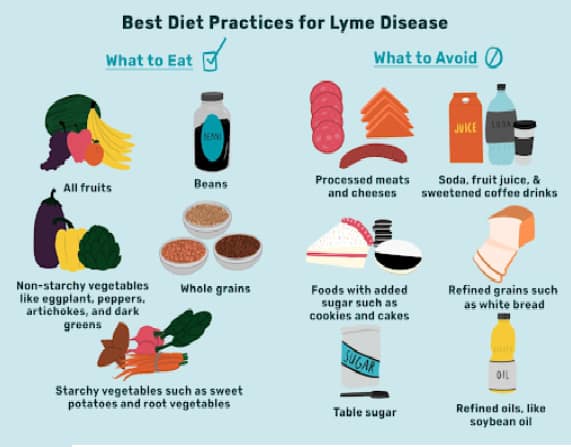
Lyme disease is extremely harmful if it is left unnoticed at the early stages. Therefore it necessitates the need for the knowledge of knowing and understanding the treatment options for Lyme disease. Even though the disease has multiple symptoms it has challenges in diagnosing it at the early stages.
Let’s explore more into details of diagnostic tests and the treatment options available to the patient.
How is Lyme Disease Diagnosed?

Accurate and early diagnosis is crucial for the effective treatment of Lyme disease. Physicians will consider all of the clinical assessments, medical histories, and tests in the laboratory to assess the infection.
ELISA Test
- Detects antibodies against Borrelia burgdorferi.
- Its sensitivity varies depending on the stage of the infection.
- Early infections will result in false negatives since not many antibodies are produced.
Western Blot Test
- Utilized to verify the ELISA results, whether they are positive or indeterminate.
- Detects specific proteins of Borrelia burgdorferi bacteria in the body.
- Reduces false positives when used together with ELISA.
PCR Test
- Detects DNA of the Borrelia burgdorferi in blood or tissue samples.
- Sensitive – but less specific when early in an infection.
CSF Analysis
- It detects any cases of Lyme-related neurologic symptomatology in the CSF.
- Performed when Lyme meningitis or neuroborreliosis suspected
Challenges to Lyme Testing
- Testing too early may miss with markers as the antibodies needed for detection are not produced.
- Fever and rashes tend to overlap with other infections hence making Lyme misdiagnosis.
- Timing and the combination of tests are critical for accuracy.
A holistic approach using these diagnosis methods ensures a precise diagnosis and a proper treatment plan.
Treatment Options for Lyme Disease
Pharmacological Treatment :
- Antibiotics serve as the primary treatment for patients suffering from Lyme disease. Depending on the patient condition the form (oral or intravenous) and dosage may vary. Following is the list of treatment options available.
- Therefore, integrating holistic approaches with conventional medical approaches can offer a comprehensive strategy for managing Lyme disease. The individualised care and professional consultation are paramount to ensure safety and efficacy.

Non Pharmacological Treatment :

- Herbal Protocols: Andrographis, Japanese knotweed, and cat’s claw which are known to be potent herbal anti infectives and anti-inflammatory agents.
- Acupuncture: This therapy involves stimulating certain points on the body through needles. It helps in pain reduction, improves blood flow, and eases fatigue and joint pain.
- Mind-Body Practices: Yoga, meditation, and mindfulness help reduce stress and improve relaxation, which are essential for managing chronic Lyme symptoms.
- Hyperbaric Oxygen Therapy (HBOT): The theory behind using this therapy is that breathing pure oxygen in a pressurized room would kill the Lyme bacteria, as it creates an environment where bacteria cannot thrive.
Inclusion of complementary or alternative therapies can improve health by enhancing the function of the immune system, and reducing inflammation.
These therapies complement, but do not replace, evidence-based conventional medicine. Always consult your doctor before you proceed with alternative treatments.
Diet and Nutrition for Lyme Disease Recovery

- Anti-Inflammatory Foods: The intake of food such as fatty fish, leafy greens, berries, nuts, and seeds are anti-inflammatory in nature reduces inflammation.
- Probiotics: The foods rich in probiotics such as yogurt, kefir, and fermented vegetables with antibiotics are essential to help restore gut health.
- Avoid Processed Foods: Processed foods and sugars as they will inhibit immunity and lead to inflammation. Better avoid such foods.
- Hydration: Proper hydration with water and herbal drinks, such as dandelion or ginger tea help with the detoxification process.
- Supplements for nutrition: In Lyme patients, there is a possibility of most common deficiencies in vitamins D, B-complex, and magnesium. Supplement may help feel better health.
Lyme disease recovery can be made faster with proper diet and nutrition. It helps to increase energy levels, reduce inflammation and strengthen immunity.
Detoxing for Lyme: Does It Help?

- Epsom Salt Baths: Magnesium-rich Epsom salts help relax the person and relieve muscle aches.
- Dry Brushing: Dry brushing facilitates lymphatic drainage for removal of toxins.
- Sauna Therapy: Infrared sauna therapy encourages sweating as it enables the removal of toxins via the skin.
- Food Supports Liver Detox: These include beets, turmeric, and milk thistle.
Detoxification enables the body to flushout toxins resulting from the Jarisch-Herxheimer reaction. and helps in the fast recovery process.
Detoxification methods can ease symptoms but it should be combined with conventional medical treatment. Always take advice from your physician before considering any of the complementary methods in addition to medical treatment.
Physical Therapy for Lyme-Induced Joint Pain
Lyme arthritis ( joint inflammation) is one of the most common complications that patients may experience. Yet physical therapy can significantly relieve pain and restore joint function.
How Physical Therapy Assists?
- Specific exercises can rehabilitate motion and improve flexibility.
- Massage and heat therapy techniques can help in pain reduction.
- Avoids chronic destruction by strengthening the joints.
- Maintains overall functionality as balance and coordination are improved.
Therapeutic Methods
- Hydrotherapy: Low-impact water therapy minimizes stress on joints.
- Electrical Stimulation: It helps in diminishing inflammation and pain in joints.
- Postural Training: It relieves strain and prevents further complications.
Combining physical therapy with medical care and lifestyle changes may enhance recovery and improve quality of life.
Conclusion
- Holistic treatments support Lyme disease recovery, especially in chronic cases, with the medications alongside aiding in faster and efficient recovery.
- Always consult a healthcare professional when combining holistic and conventional treatments.
- Consistent lifestyle changes, including stress reduction, sleep improvement, and exercise, are essential for holistic healing.
- Lyme disease needs timely intervention to prevent long-term complications.
References
- Hatchette TF, Davis I, Johnston BL. Lyme disease: clinical diagnosis and treatment. Can Commun Dis Rep. 2014;40(11):194-208. Published 2014 May 29. Link.
- Lindsay LR, Bernat K, Dibernardo A. Laboratory diagnostics for Lyme disease. Can Commun Dis Rep 2014;40:209–17. [DOI] [PMC free article] [PubMed] [Google Scholar]
- Feng J, Leone J, Schweig S, Zhang Y. Evaluation of Natural and Botanical Medicines for Activity Against Growing and Non-growing Forms of B. burgdorferi. Front Med (Lausanne). 2020;7:6. Published 2020 Feb 21. Link
- Steere AC, Sikand VK. The presenting manifestations of Lyme disease and the outcomes of treatment. N Engl J Med 2003. Jun;348(24):2472–4. 10.1056/NEJM200306123482423 [DOI] [PubMed] [Google Scholar]


